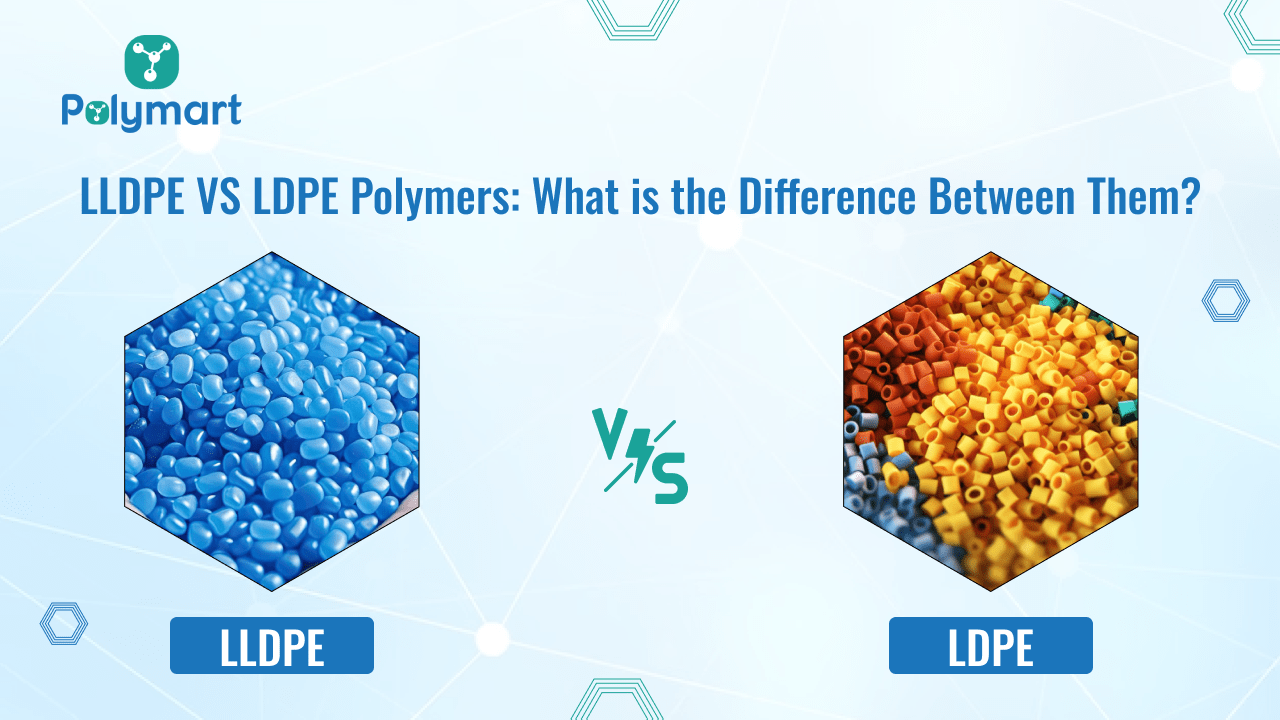
In the subject of polymer chemistry, the contrast between LLDPE (Linear Low-Density Polyethylene) and LDPE (Low-Density Polyethylene) stands as a pivotal point of discussion. These two polymers share similarities and yet exhibit distinct characteristics that set them apart.
According to studies, the polyethylene market size is expected to rise to USD 36.83 billion by 2028 at a compound annual growth rate of 5.53%. LDPE polymers account for the largest share of the polyethylene market in daily life.
So, without further ado; let’s unravel the intricacies of LLDPE vs LDPE and explore their roles in shaping the modern world of materials science and applications.
What are the Definitions of LLDPE VS LDPE Polymers?
Before we go through the LLDPE and LDPE polymers difference, understand the basic definition for complete understanding. LLDPE and LDPE are the family members of polyethylene – a commonly used polymer in our daily lives.
Linear Low-Density Polyethylene (LLDPE) is a type of polyethylene polymer characterised by its linear molecular structure. It is produced through the copolymerization of ethylene with longer-chain alpha-olefins, such as butene, hexane, or octane. This results in a more linear and less branched polymer structure compared to LDPE.
Compared to linear low-density polyethylene (LLDPE), low-density polyethylene (LDPE) is its brother. LLDPE is a thermoplastic derived from the monomer ethylene. It was the first grade of polyethylene produced in 1933 and defined by a density range of 917–930 kg/m3.
Additionally To Buy or sell polymers online, PolyMart – a leading polymer distribution company in India provides a one-stop platform for a seamless and secured polymer procurement process. The application also offers daily price trends to make a well-informed decision.
What are the Properties of LLDPE VS LDPE Polymers?
When it comes to exploring different types of polymers and finding the difference between linear low-density polyethylene and low-density polyethylene, properties are important factors to consider. This helps you to buy the right polymer online for a particular application. The following are the properties of LLDPE vs LDPE polymers.
Properties of LLDPE Polymers:
Density (g/cm3) – 0.94 to 0.97
Tensile Strength (MPa) – 25 to 45
Flexural Modulus (GPa) – 0.28 to 0.73
Elongation at Break (%) – 300 to 900
Maximum Operating Temperature (°C) – 90 to 110
Plastic Melting Point (°C) – 130 to 160
Mold Shrinkage (%) – 2 to 2.5
Properties of LDPE Polymers:
Density (g/cm3) – 0.91 to 0.94
Tensile Strength (MPa) – 10 to 20
Flexural Modulus (GPa) – 0.24 to 0.33
Elongation at Break (%) – 200 to 600
Maximum Operating Temperature (°C) – 80 to 100
Plastic Melting Point (°C) – 105 to 115
Mold Shrinkage (%) – 2 to 4
What are the Benefits of LLDPE VS LDPE Polymers?
Linear Low-Density Polyethylene and Low-Density Polyethylene polymers offer several benefits that make them valuable in various applications. Here are the key features and benefits of LLDPE vs LDPE.
Benefits of LLDPE Polymers:
Puncture-resistant
Good flexibility
Resistant to oxidation
Excellent barrier properties
High impact strength
Stress-cracking resistance
UV resistant
Benefits of LDPE Polymers:
Greater flexibility compared to LDPE polymers
Exemplary impact resistance
Higher transparency
Ease of processing
Strong chemical resistance
What are the Uses of LLDPE VS LDPE Polymers?
LLDPE and LDPE polymers find a wide range of uses across various industries because of their versatile properties and exceptional offerings.
Uses of LLDPE Polymers:
Pallet stretch film
Garbage bags
Pond liners
Buckets
Floor tiles
Shopping bags
Industrial liners
Cable jacketing
Uses of LDPE Polymers:
Trash bags
Shrink film
Squeeze bottles
Frozen food bags
Plastic household products
A Quick Look at the LLDPE VS LDPE Difference Between Table:
Here’s a comparison table outlining the key differences between Linear Low-Density Polyethylene (LLDPE) and Low-Density Polyethylene (LDPE):
| Feature | LLDPE | LDPE |
| Polymer Structure | Linear | Branched |
| Polymer Density | Higher | Lower |
| Polymer Melt Strength | Higher | Lower |
| Polymer Flexibility | Greater | Less |
| Polymer Tensile Strength | Higher | Lower |
| Impact Resistance | Better | Moderate |
| Polymer Heat Stability | Good | Excellent |
| Clarity | Less Transparent | More Transparent |
| Processing Characteristics | Easier to process at high speeds | More challenging at high speeds |
| Applications | Packaging films, liners, containers | Squeeze bottles, flexible packaging |
Conclusion:
If you’re in doubt about whether to choose LLDPE or LDPE polymers, we hope our article has provided you with a comprehensive understanding of the differences between them. Whether you’re interested in purchasing LDPE polymers or selling LLDPE polymers online, PolyMart has got you covered. As a leading polymer distribution company in India, our app will assist you in making the best decision for your business. Install the PolyMart Buyer App and feel free to get in touch with our team for further details.